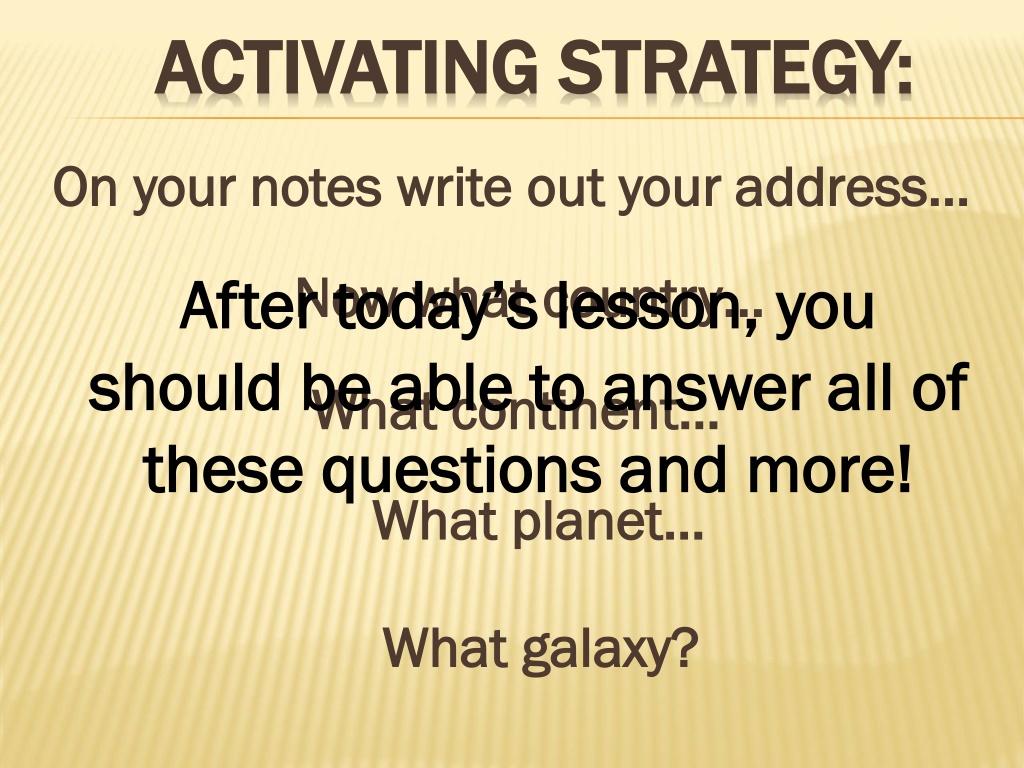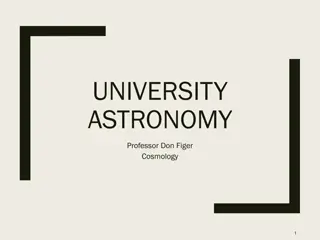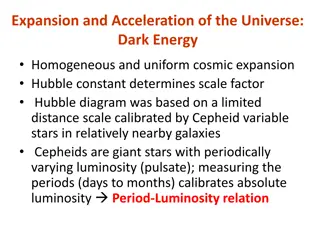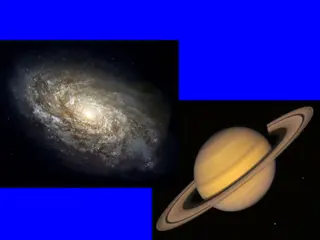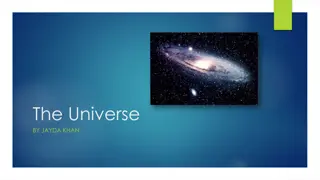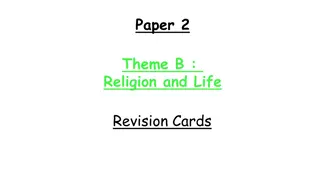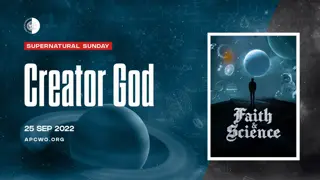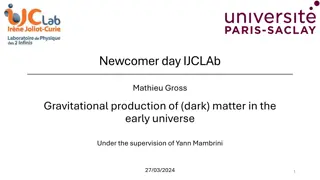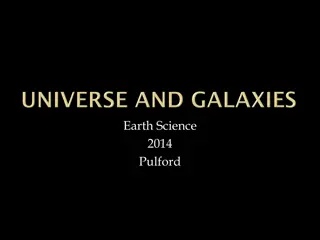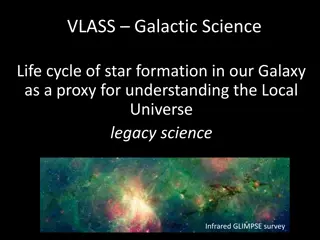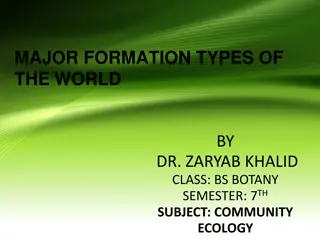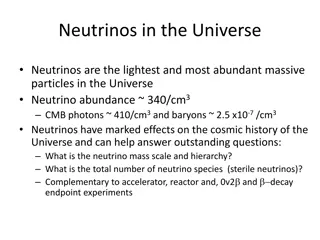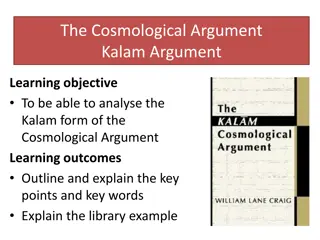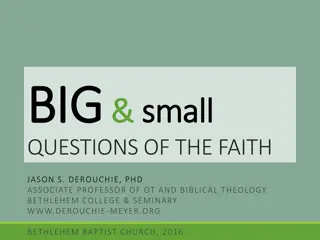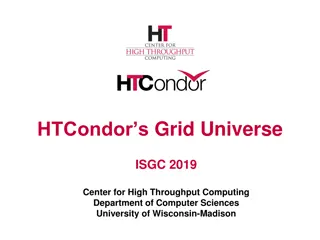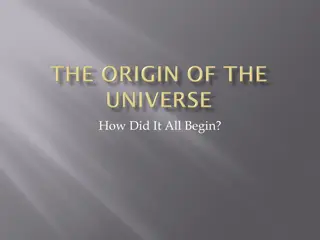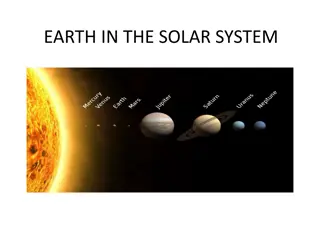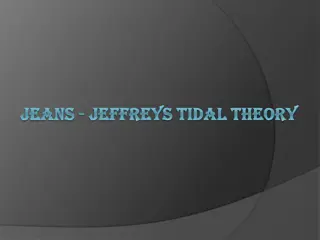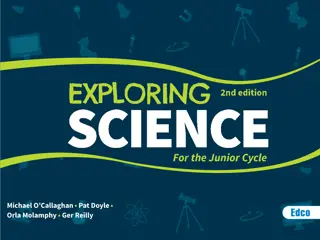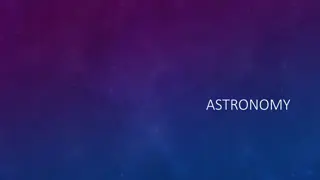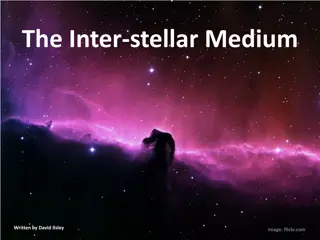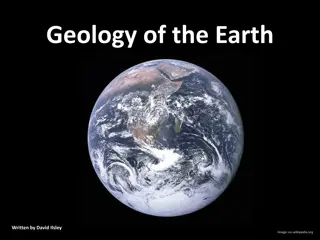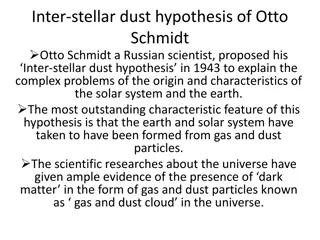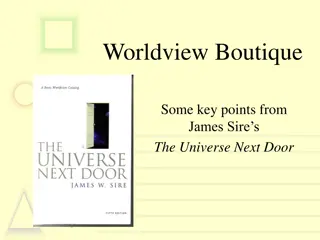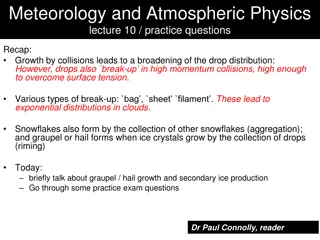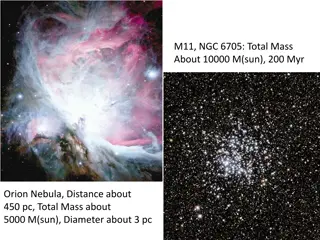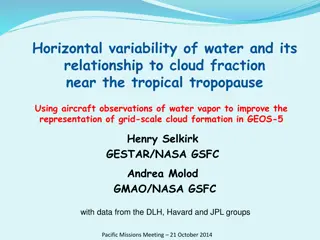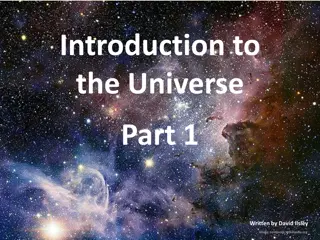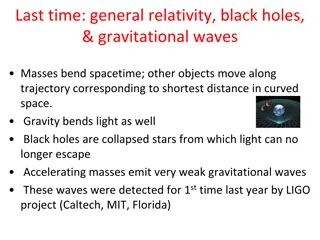Exploring the Formation of Our Universe
Delve into the intriguing theories and concepts surrounding the formation of the universe, including the Big Bang Theory and the development of solar systems. Learn about the positioning of our solar system in the Milky Way Galaxy and understand how scientists believe solar systems formed after the Big Bang, shedding light on the evolution of the universe and celestial bodies over millions of years.
Download Presentation

Please find below an Image/Link to download the presentation.
The content on the website is provided AS IS for your information and personal use only. It may not be sold, licensed, or shared on other websites without obtaining consent from the author. Download presentation by click this link. If you encounter any issues during the download, it is possible that the publisher has removed the file from their server.
E N D
Presentation Transcript
ACTIVATING STRATEGY: ACTIVATING STRATEGY: On your notes write out your address On your notes write out your address Now what country Now what country After today s lesson, you After today s lesson, you should be able to answer all of should be able to answer all of these questions and more! these questions and more! What continent What continent What planet What planet What galaxy? What galaxy?
HOW IS OUR SOLAR SYSTEM HOW IS OUR SOLAR SYSTEM POSITIONED IN THE MILKY WAY POSITIONED IN THE MILKY WAY GALAXY AND THE UNIVERSE? GALAXY AND THE UNIVERSE? S6E1b. Describe the position of the solar system in the Milky Way Galaxy and S6E1b. Describe the position of the solar system in the Milky Way Galaxy and the universe. the universe.
LETS REVIEW Turn to a seat partner and Turn to a seat partner and discuss the theory on how discuss the theory on how the universe was formed. the universe was formed.
THE BIG BANG THEORY The most commonly accepted theory today of the formation of the universe is the Big Bang Theory. The theory states that the universe originated sometime between 10 billion and 20 billion years ago from an enormous explosion of a small volume of matter at extremely high density and temperature.
Lets review the Let s review the formation of other formation of other objects within the solar objects within the solar system. system.
THE UNIVERSE AFTER ITS BIG BANG Scientists believe that Solar Systems formed Scientists believe that Solar Systems formed in similar ways. Giant clouds of dust and gas in similar ways. Giant clouds of dust and gas began to collapse under the weight of its began to collapse under the weight of its own gravity. As it did so, the matter own gravity. As it did so, the matter contained within it began to move in a giant contained within it began to move in a giant circle, much like the water in a drain moves circle, much like the water in a drain moves the dust and gas that collapsed into it. the dust and gas that collapsed into it. our Sun, while the smaller clumps became the our Sun, while the smaller clumps became the parts of the universe we know parts of the universe we know today. today. As millions of years passed, the dense areas As millions of years passed, the dense areas of the universe pulled in material because of the universe pulled in material because they had more gravity. Finally, about 100 they had more gravity. Finally, about 100 million years after the Big Bang, the gas million years after the Big Bang, the gas became hot and dense enough for the first became hot and dense enough for the first stars to form. Large clusters of stars soon stars to form. Large clusters of stars soon became the first galaxies. became the first galaxies. around the center of the drain in a circle. around the center of the drain in a circle. planets, minor planets, moons, comets, and planets, minor planets, moons, comets, and asteroids. asteroids. In short, after the Big Bang, In short, after the Big Bang, dense clouds of gas and dust dense clouds of gas and dust Further away from the center of this mass where Further away from the center of this mass where the star was forming, there were smaller clumps the star was forming, there were smaller clumps of dust and gas that were also collapsing. of dust and gas that were also collapsing. from the bang either collapsed from the bang either collapsed At the center of this spinning cloud, a small At the center of this spinning cloud, a small star began to form. This star grew larger star began to form. This star grew larger and larger as it collected more and more of and larger as it collected more and more of The star in the center eventually ignited forming The star in the center eventually ignited forming or stuck together to form the or stuck together to form the
The Universe contains billions of The Universe contains billions of galaxies containing millions or billions of stars. containing millions or billions of stars. galaxies, each , each Therefore, the galaxy in which our solar system Therefore, the galaxy in which our solar system and essentially all of us live, is just one of and essentially all of us live, is just one of billions. billions.
Distributed Summarizing: Turn to a seat Distributed Summarizing: Turn to a seat partner and come up with a comparison of partner and come up with a comparison of our galaxy within the universe. our galaxy within the universe.
Our galaxy is called __________________. Our galaxy is called __________________. the Milky Way Galaxy the Milky Way Galaxy
THE MILKY WAY GALAXY THE MILKY WAY GALAXY Contains single star systems, double stars, and dust and gas It is a spiral galaxy because it has spiral arms that wind outward from the center
THE MILKY WAY GALAXY THE MILKY WAY GALAXY Why is our galaxy called the Milky Way? Thousands of years ago people thought the stars appeared as a patchy band of light like a flowing river of milk, thus the name Milky Way. Also, the word galaxy comes from the Greek word gala, meaning milk.
OUR SOLAR OUR SOLAR SYSTEM SYSTEM Our solar system is a Our solar system is a single star system single star system located on an outer located on an outer rim (arm) of the rim (arm) of the Milky Way Galaxy. Milky Way Galaxy.
OUR SOLAR SYSTEM OUR SOLAR SYSTEM Here is another view of the location of our Here is another view of the location of our solar system in the Milky Way Galaxy. solar system in the Milky Way Galaxy.
STUDY JAMS: THE SOLAR SYSTEM
SCALE OF THE UNIVERSE SCALE OF THE UNIVERSE ANIMATION ANIMATION DIGITAL UNIVERSE https://www.youtube.com/watch?t=64&v=17jymDn0W6U EXAMINE THE MILKY WAY EXAMINE THE MILKY WAY GALAXY AT DIFFERENT SCALES GALAXY AT DIFFERENT SCALES
DISTRIBUTED SUMMARIZING: DISTRIBUTED SUMMARIZING: The map to the right shows The map to the right shows Troup County. The lines and Troup County. The lines and numbers represent numbers represent interstates and major roads interstates and major roads running through Troup running through Troup County. County. Imagine that the circle in the Imagine that the circle in the middle of the map is the middle of the map is the center of the Milky Way center of the Milky Way Galaxy. Draw an asterisk (*) Galaxy. Draw an asterisk (*) showing where the Solar showing where the Solar System might be located on System might be located on our Troup County map. our Troup County map.
SUMMARIZING SUMMARIZING STRATEGY STRATEGY Universe Universe Match Match- -up up
